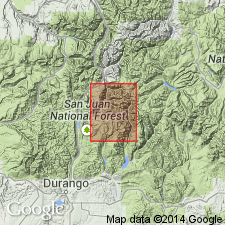
- Usage in publication:
-
- Eolus granite*
- Modifications:
-
- Original reference
- Dominant lithology:
-
- Granite
- AAPG geologic province:
-
- Southern Rocky Mountain region
Summary:
Eolus granite. Coarse pink hornblende-biotite granite. Occupies about one-third of quadrangle, and composes Mount Eolus, in southwestern Colorado. Intrudes Archean schists and Uncompahgre formation (Algonkian), and is unconformably overlain by Ignacio quartzite [Upper Cambrian].
[GNC remark (ca. 1936, US geologic names lexicon, USGS Bull. 896, p. 693): The terms "Algonkian system" and "Archean system" were discarded by the USGS in 1934. For 1935 Colorado geol. map this formation was included in Front Range granite group and assigned to pre-Cambrian.]
Source: US geologic names lexicon (USGS Bull. 896, p. 693).
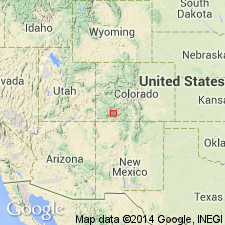
- Usage in publication:
-
- Eolus Granite*
- Modifications:
-
- Overview
- Areal extent
- Geochronologic dating
- AAPG geologic province:
-
- Southern Rocky Mountain region
Summary:
Covers about 100 sq mi in southern Needle Mountains between Vallecito Creek and east rim of canyon of Animas River, La Plata Co, CO in Southern Rocky Mountain region. Forms two composite batholiths. Good exposures found in Florida River, and Johnson, Needle, and Sunlight Creeks. Extends south under Paleozoic cover. A second body underlies Pine River and extends east into upper reaches of Sand, Little Sand, and Weminuche Creeks, and extends under Paleozoic and Mesozoic rocks. Both bodies were mapped (Larson, Cross, 1956) as Pine River batholith. Name applied to all variants of these masses. Is mostly massive gray, pink to brick-red biotite-hornblende quartz monzonite. Conspicuous 1/2 to 1 1/2 in pink blocky carlsbad-twinned microcline microperthite are set in a medium- to coarse-grained matrix of blocky andesine, gray-blue quartz, commonly in clusters, tabular- to irregular-shaped, golden to dark brown biotite, and hornblende. Chemical analyses. Western body has an intrusive contact with Irving Formation, and a U-Pb age of 1,460 +/-20 m.y. Eastern body crosscuts quartzite and schist of Uncompahgre, Vallecito, and Irving Formations, and has a K-Ar age of 1,460 +/-70 m.y. on hornblende and 1,390 +/-40 m.y. on biotite. Both bodies have a Rb-Sr whole-rock isochron of 1,466 +/-27 m.y. Geologic sketch map; shown as equivalent in age to Electra Lake Gabbro, younger than quartz diorite of Pine River, and older than Trimble Granite.
Source: GNU records (USGS DDS-6; Denver GNULEX).
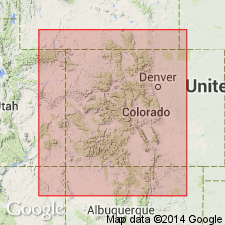
- Usage in publication:
-
- Eolus Granite*
- Modifications:
-
- Overview
- AAPG geologic province:
-
- Southern Rocky Mountain region
Summary:
Occurs in two batholithic bodies in Needle Mountains. Listed with granitic rocks and gabbro of circa 1,400 m.y. (Precambrian Y) age group.
Source: GNU records (USGS DDS-6; Denver GNULEX).
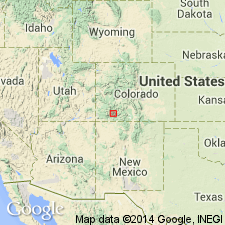
- Usage in publication:
-
- Eolus Granite
- Modifications:
-
- Revised
- AAPG geologic province:
-
- Southern Rocky Mountain region
Summary:
Intrudes the Uncompahgre Formation of Middle Proterozoic rocks in contact relationship and depositional sequence reinterpreted. Uncompahgre Formation deposited before 1,640 m.y. and deformed before 1,430 m.y. New relationship shown on Figure 1.
Source: GNU records (USGS DDS-6; Denver GNULEX).
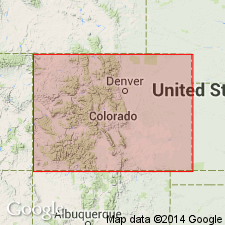
- Usage in publication:
-
- Eolus Granite*
- Modifications:
-
- Areal extent
- Overview
- AAPG geologic province:
-
- Southern Rocky Mountain region
Summary:
Is one of ten formally named lithodemic units assigned to the Middle Proterozoic Berthoud Plutonic Suite (a new name) in the Southern Rocky Mountain region. Known in two small batholiths about 10 km apart in Needle Mountains. Is principally a pink to brick-red biotite hornblende quartz monzonite. Western batholith has a 1,438 +/-20 m.y. age on U-Pb in Zr. Both batholiths have a 1,444 +/-27 m.y. age on whole rock Rb-Sr.
Source: GNU records (USGS DDS-6; Denver GNULEX).
For more information, please contact Nancy Stamm, Geologic Names Committee Secretary.
Asterisk (*) indicates published by U.S. Geological Survey authors.
"No current usage" (†) implies that a name has been abandoned or has fallen into disuse. Former usage and, if known, replacement name given in parentheses ( ).
Slash (/) indicates name conflicts with nomenclatural guidelines (CSN, 1933; ACSN, 1961, 1970; NACSN, 1983, 2005, 2021). May be explained within brackets ([ ]).

